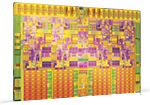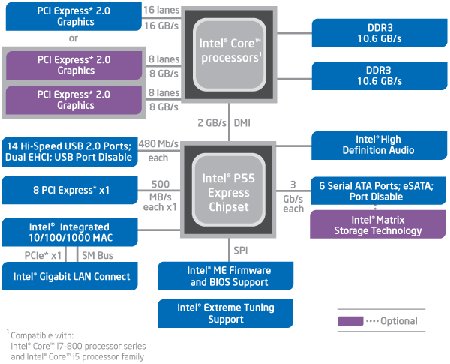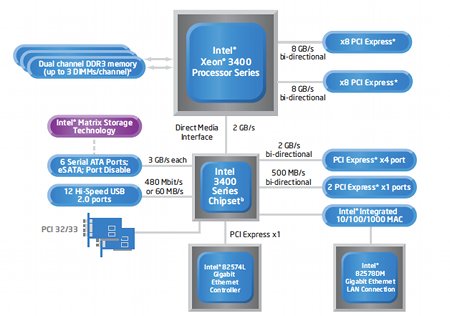New Intel CPUs have quad cores, onboard graphics
Sep 9, 2009 — by LinuxDevices Staff — from the LinuxDevices Archive — 7 viewsIntel has announced several new processors that bring its high-end “Nehalem” architecture to mainstream desktop PCs and entry-level servers. In addition to the Core i5, i7, and Xeon 3400 processors, the chipmaker released the “revolutionary” P55 Express Chipset, touted as “the baseline building block component for [future] motherboards worldwide.”
 Intel's announcements yesterday bring the company's Nehalem architecture — unveiled last year in high-end Core i7 processors — to a lower price point. The new Core i5 (right) and i7 processors, previously code-named "Lynnfield," are "designed for consumers who need top-notch performance for digital media, productivity, gaming and other demanding applications," according to Intel.
Intel's announcements yesterday bring the company's Nehalem architecture — unveiled last year in high-end Core i7 processors — to a lower price point. The new Core i5 (right) and i7 processors, previously code-named "Lynnfield," are "designed for consumers who need top-notch performance for digital media, productivity, gaming and other demanding applications," according to Intel.
|
Name |
Clock speed (GHz) |
Turbo speed (GHz) |
Cores/Threads |
Cache |
Price (US$) |
Hyper-threading? |
TDP |
|
Core i7-870 |
2.93 |
Up to 3.6 |
4/8 |
8MB |
$562 |
Yes |
95W |
|
Core i7-860 |
2.80 |
Up to 3.46 |
4/8 |
8MB |
$284 |
Yes |
95W |
|
Core i5-750 |
2.66 |
Up to 3.2 |
4/4 |
8MB |
$196 |
No |
95W |
As detailed in the table above — and in coverage on our sister site eWEEK.com — the quad-core Core i5 and i7 CPUs are built using a 45nm manufacturing process, feature integrated memory controllers, and offer a Turbo Boost feature that can scale their clock speeds up on demand. With prices of at least $200 and 95-Watt TDPs, these new processors aren't headed for embedded devices anytime soon. We think they're significant, however, because they're all designed to work with Intel's P55 Express Chipset, also announced yesterday.
All three Lynnfield CPUs bring memory and graphics controllers onto the CPUs themselves. As shown in the block diagram below, the Core i5 and i7 CPUs include both dual-channel, DDR3 memory support, and PCI Express 2.0 Graphics, the latter configurable either as a single x16 link or as two x8 links.

A block diagram of Intel's Lynnfield processors and P55 Express Chipset
(Click to enlarge)
The P55 Graphics Express Chipset (above), meanwhile, adds functionality including eight PCI Express x1 lanes, a gigabit Ethernet port, 14 USB 2.0 ports, six SATA ports (with RAID 0/1/5/10 support), eSATA, and high definition audio. The P55 is linked to the CPU by a 2GB/sec. Direct Media Link (DMI), similar to the technology previously used to connect the chipmaker's northbridge and southbridge components.
Despite being called a "chipset" by Intel, the P55 consists of just a single, 65nm chip, the P55 Express Platform Controller Hub (PCH), which measures just 9 x 8.5mm. Touted as bringing "the most revolutionary design changes since the invention of the PCI bus in the early 1990s," the P55 will support lower-end CPUs in the future, or so Intel's release suggests: "The P55 Express Chipset will be the baseline building block component for motherboards worldwide," the company says.
New Xeon CPUs
Announced along with the Core i5, i7, and P55 were new Xeon 3400 processors, featuring quad cores and clock speeds from 1.86GHz to 2.93GHz. Like the Core CPUs, the new Xeons (below) are billed as using Nehalem microarchitecture, and they're paired with Platform Controller Hubs known as the 3400 and 3420.
|
Name |
Clock speed (GHz) |
Turbo speed (GHz) |
Cores/Threads |
Cache |
Price (US$) |
Hyper-threading? |
TDP |
|
Xeon X3470 |
2.93 |
Up to 3.6 |
4/8 |
8MB |
$589 |
Yes |
95W |
|
Xeon X3460 |
2.80 |
Up to 3.46 |
4/8 |
8MB |
$316 |
Yes |
95W |
|
Xeon X3450 |
2.66 |
Up to 3.2 |
4/8 |
8MB |
$241 |
Yes |
95W |
|
Xeon X3440 |
2.53 |
Up to 2.93 |
4/8 |
8MB |
$215 |
Yes |
95W |
|
Xeon X3430 |
2.40 |
Up to 2.8 |
4/4 |
8MB |
$189 |
No |
95W |
|
Xeon L3426 |
1.86 |
Up to 3.2 |
4/8 |
8MB |
$284 |
Yes |
45W |
The latter "chipsets" are apparently similar to the P55 mentioned above, but with some functionality disabled. For example, the economy-minded 3400 (below) does not include RAID support, has only four SATA ports and eight USB ports, and is limited to six PCI Express x 1 lanes. Similarly, the 3420 has only 12 USB 2.0 ports, according to Intel.

A block diagram of Intel's Xeon 3400 and 3400 series chipset
(Click to enlarge)
While none of the Xeons is quite appropriate for what we'd consider an embedded device, the Xeon L3426 clocks at 1.86GHz, has a "turbo frequency" of up to 3.2GHz, and uses just 45 Watts, according to Intel. The chip will "enable innovative server form factors for space and thermally constrained environments," the company says.
Availability
Intel did not spell out availability for the new CPUs or P55 Graphics Express Chipset, but all appear to be available already, judging by the fact that The Tech Report has published a test of the Core i5-750 in three Lynnfield-ready, P55-equipped motherboards — Asus' P7P55D Deluxe, Gigabyte's GA-P55-UD6, and MSI's P55-GD65.
To see The Tech Report comparison test, see the publication's website, here. To see eWEEK's coverage of the new Core i5, i7, and Xeon processors, go here.
This article was originally published on LinuxDevices.com and has been donated to the open source community by QuinStreet Inc. Please visit LinuxToday.com for up-to-date news and articles about Linux and open source.